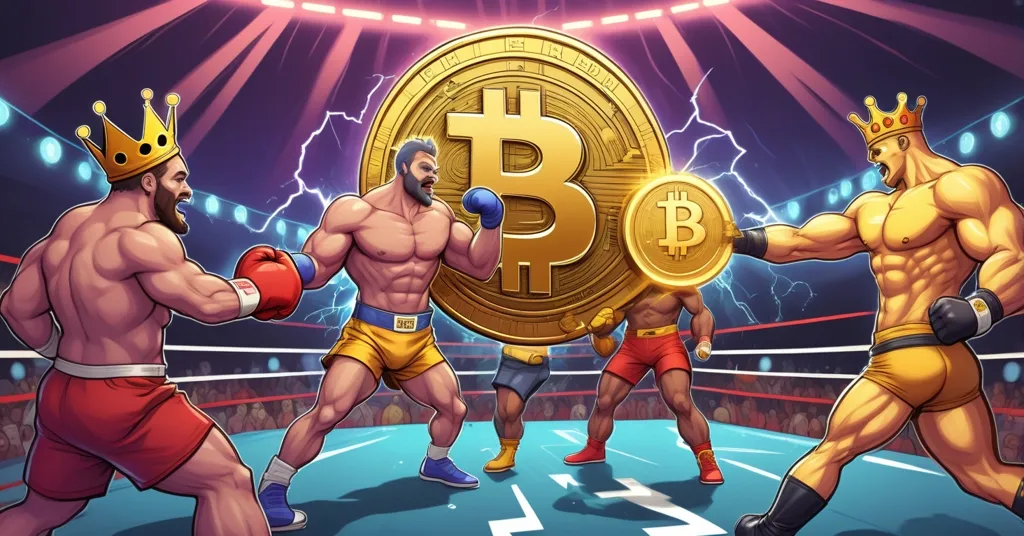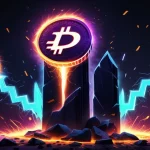Altcoins Rise: Are They Breaking Free from Bitcoin’s Dominance?

Cryptocurrency Market Shift: Are Altcoins Finally Breaking Free from Bitcoin’s Shadow?
Bitcoin has been the undisputed heavyweight champ of crypto for over a decade, but the ring is getting crowded. Altcoins like Ethereum, Solana, and XRP are throwing punches, gaining ground with innovation and investor interest, while Bitcoin’s grip on market dominance slips to levels not seen in months. Is this the dawn of a true altcoin era, or just a flashy distraction before Bitcoin reclaims the throne?
- Bitcoin Dominance Dips: Falling to 59-61%, signaling capital trickling into altcoins.
- Altcoin Momentum: Ethereum, Solana, XRP, and BNB post 20-40% gains this quarter, though a full “altseason” isn’t here yet.
- Market Evolution: Shifting to a “multi-orbital” structure with Bitcoin as the reserve asset and altcoins driving tech breakthroughs in AI, Real-World Assets (RWAs), and scalability solutions.
A Glimpse Back: How Market Cycles Have Evolved
Bitcoin, born in 2009 as a radical middle finger to centralized finance, has long dictated the tempo of crypto markets. Remember the 2017 ICO frenzy? Altcoins exploded with hype, promising to revolutionize everything from gaming to supply chains, only for most to crash and burn in the ensuing bear market. Fast forward to 2021’s DeFi summer, where Ethereum and its ecosystem of decentralized finance apps showed altcoins could offer real utility, not just empty promises. Each cycle saw Bitcoin lead the charge, with altcoins riding its coattails—until now. Today’s market feels different. Bitcoin’s dominance, a metric showing its share of total crypto market cap, has dipped below 60% for the first time in six months, per recent data from platforms like CoinGecko. This isn’t just a blip; it’s a sign that altcoins might finally be carving their own path, fueled by tech that Bitcoin, by design, doesn’t touch. For a deeper look into Bitcoin dominance trends and altcoin capital rotation, the numbers paint a compelling picture.
Bitcoin’s Ironclad Hold: Why Institutions Still Bow to the King
Let’s get one thing straight: Bitcoin isn’t going anywhere. It’s the safe bet, the digital gold that institutions like Deutsche Bank, State Street, and Citi are piling into for custody solutions after regulatory hurdles eased. Why the love? Bitcoin’s classified as a commodity by the U.S. Commodity Futures Trading Commission (CFTC), giving it a clearer legal runway than most altcoins, which get slapped with the “security” label by the SEC and Europe’s ESMA. That means less red tape, lower compliance headaches, and a smoother path to mainstream adoption. Bitcoin maximalists—those diehards who believe BTC is the only true decentralized currency—argue it’s the ultimate store of value, untainted by the overcomplicated bells and whistles of altcoins. And they’ve got a point: Bitcoin’s simplicity and proven track record over 16 years make it a fortress in a market often riddled with scams and volatility. Curious about why institutions lean toward Bitcoin over altcoins? The reasoning often boils down to stability and regulatory clarity.
But here’s the flip side. A dominance drop to 59-61% suggests even the big players are peeking at the altcoin space, diversifying their bets as risk appetite grows. Technical analysts like Luca from Mitrade note that Bitcoin dominance breaking key weekly support levels signals a shift in sentiment. Luca even predicts a potential bottom at 47-48%, after which Bitcoin could roar back and crush any budding altcoin rally. So, is this a temporary lapse or a permanent pivot? That’s the million-dollar question.
Altcoin Surge: Innovation Stealing the Spotlight
While Bitcoin plays the steady anchor, altcoins are the wildcards shaking things up. Ethereum (ETH), Solana (SOL), XRP, and Binance Coin (BNB) have racked up gains of 20-40% this quarter, outpacing Bitcoin’s steadier climb. Ethereum remains the heavyweight among altcoins, thanks to its smart contract ecosystem—think of it as a global computer running decentralized apps (dApps) for everything from lending to gaming. Its staking mechanism, post-2022 Merge, lets users lock up ETH to secure the network and earn rewards, a feature Bitcoin lacks. Solana, meanwhile, is the speed demon, offering lightning-fast transactions and scalability that make it a go-to for developers building DeFi platforms or NFT marketplaces. XRP, tied to Ripple’s cross-border payment tech, and BNB, the fuel for Binance’s exchange empire, are also drawing eyes. Even newer names like Aptos and SEI are catching heat from giants like BlackRock and Bitwise for their focus on high-speed transactions and compatibility with Ethereum’s tools. For insights on Ethereum’s innovations and broader altcoin market shifts, the future looks ripe with potential.
Beyond raw gains, altcoins are pioneering sectors Bitcoin doesn’t touch. Take Real-World Assets (RWAs)—think tokenized real estate or commodities on blockchains like Ethereum or Chainlink, tradeable 24/7 without middlemen. Then there’s Layer-2 solutions, like Arbitrum and Optimism on Ethereum, which act as side roads to the main highway, processing transactions cheaper and faster while still securing them on the base network. Add in altcoin projects tied to artificial intelligence (AI) tokens or modular blockchains, and you’ve got a playground of disruption. As Vugar Usi Zade, COO at Bitget, nails it:
“The market is becoming multi-orbital—BTC as the reserve asset, ETH and other leaders driving innovation—and managers will need macro-aware, sector-specific strategies to thrive.”
Could tokenized property on Ethereum be the next trillion-dollar market, or just another shiny gimmick? That’s for the market to decide, but one thing’s clear: altcoins are pushing boundaries Bitcoin was never meant to cross.
Regulatory Quagmires: The Chains Holding Altcoins Back
Before you go all-in on altcoins, let’s talk about the elephant in the room: regulation. Bitcoin gets a relatively free pass as a commodity, but altcoins? They’re often caught in a legal shitstorm, branded as securities by the SEC and ESMA, which means stricter rules, hefty compliance costs, and constant lawsuits. Take the SEC’s ongoing war with Ripple over XRP—years of litigation have left investors skittish, even as XRP posts gains. Europe’s MiCA framework promises some standardization but still burdens smaller altcoin projects with paperwork most can’t afford. This fragmented mess is why institutions cling to Bitcoin like a life raft in choppy waters. For a deeper dive into regulatory challenges facing altcoins, the academic perspective highlights the complexity.
Yet, there are glimmers of hope. Recent ETF approvals—like ProShares Ultra XRP Futures ETF (UXRP) and Volatility Shares 2x Solana ETF (SOLT)—show Wall Street’s interest creeping beyond Bitcoin. These exchange-traded funds let investors bet on altcoin price swings without holding the assets directly, a cautious but telling step. Zade puts it sharply:
“Regulatory gaps are creating moats around blue-chip assets, though ETF approvals for XRP and SOL hint at the coming wave of institutional altcoin exposure.”
Still, let’s not sugarcoat it. For every Ethereum or Solana, there’s a freaking swamp of scams and rug pulls in the altcoin space, especially among small-cap tokens. Naive investors get burned daily by projects promising the moon and vanishing overnight. Then there’s technical baggage—Solana’s history of network outages or Ethereum’s past smart contract hacks remind us these platforms aren’t bulletproof. Altcoins pack innovation, but they also pack volatility and risk far beyond Bitcoin’s battle-tested stability. If you’re curious about recent altcoin ETF approvals and institutional interest in XRP and Solana, the updates are worth tracking.
Multi-Orbital Market: A New Crypto Frontier or Temporary Hype?
The idea of a “multi-orbital” market isn’t just jargon—it’s a framework for understanding this shift. Bitcoin sits as the reserve asset, the digital gold standard for value storage, while altcoins orbit around it, each with unique niches. Ethereum drives DeFi and staking; Solana powers high-speed dApps; XRP tackles cross-border payments. This isn’t Bitcoin losing—it’s the market maturing into a diverse ecosystem where different assets serve different purposes. Zade captures this evolution:
“Altcoins are setting their own beat—Bitcoin’s still king, but it’s not calling all the shots anymore.”
This ties directly to the spirit of effective accelerationism (e/acc)—the idea that rapid experimentation, even with failures, pushes tech forward. Altcoins, with their messy trial-and-error in DeFi, RWAs, and beyond, are accelerating blockchain’s disruption of traditional finance, challenging banks and governments at every turn. But let’s play devil’s advocate: Bitcoin maximalists argue this fragmentation dilutes the vision of a single, decentralized currency. They’ve got a case—many altcoins centralize power in ways Bitcoin avoids, whether through developer control or venture capital influence. Is this multi-orbital setup a permanent evolution, or just a chaotic detour before Bitcoin’s simplicity wins out? For a broader understanding of Bitcoin dominance and altcoin market dynamics, the foundational knowledge is key.
Then there’s the retail side—the degens and meme coin junkies fueling altcoin spikes with Twitter hype and Reddit threads. From Dogecoin’s absurd meme-driven runs to random tokens soaring overnight, this grassroots energy adds a wild, unpredictable layer institutions can’t touch. Picture a degen chucking darts at a board of shitcoins while Wall Street suits stack Bitcoin—two worlds, same chaotic market. Community discussions on Bitcoin dominance decline and altcoin momentum offer raw, unfiltered takes from the trenches.
Navigating the Chaos: Investment Strategies for a Fragmented Market
The old “buy Bitcoin and HODL” mantra won’t cut it anymore. With macro factors like inflation, interest rates, and geopolitical tensions swaying crypto markets, investors need to think bigger. Zade suggests a two-pronged approach: track broad economic trends—think inflation spikes or Fed moves—and pair that with targeted bets on altcoin niches like stablecoins, AI tokens, or Layer-2 platforms. Diversify, but don’t YOLO into every hyped token; do the damn research. And watch out for scams— if a project smells like bullshit, it probably is. For a strategic perspective on evolving market cycles and pro-altcoin investment approaches, expert opinions highlight the need for adaptability.
For asset managers, it’s about balancing Bitcoin’s stability with altcoin upside. Retail investors, meanwhile, should temper FOMO with caution. The Altcoin Season Index, which measures how many top altcoins outperform Bitcoin over time, is climbing but still below the 75% mark needed for a full-blown “altseason.” We’re seeing capital rotation, not a tidal wave. Patience and skepticism are your best friends in this wild west.
What’s Next for Bitcoin and Altcoins?
Bitcoin’s crown isn’t slipping, but it’s no longer the only game in town. Altcoins are staking their claim with raw innovation and a growing hunger for risk, yet they’re shackled by regulatory mazes and their own volatility. Whether this multi-orbital market marks a lasting shift or just a fleeting rebellion against Bitcoin’s reign, one thing’s undeniable: crypto is more complex and electrifying than ever. So, are altcoins carving a permanent spot, or just enjoying a brief spotlight? The market’s yours to decode.
Key Takeaways and Burning Questions
- How are cryptocurrency market cycles changing from Bitcoin-driven to altcoin-influenced?
We’re seeing a shift to a multi-orbital structure where Bitcoin remains the reserve asset, but altcoins like Ethereum and Solana carve independent paths with innovation in smart contracts, DeFi, AI, and Real-World Assets (RWAs). - Why do institutions still favor Bitcoin over altcoins?
Bitcoin’s regulatory clarity as a commodity, high liquidity, and established custody solutions make it a safer bet compared to altcoins, often classified as securities under stricter, fragmented rules. - Are we on the cusp of a true altseason?
Bitcoin dominance at 59-61%, 20-40% gains in major altcoins, and a rising Altcoin Season Index point to momentum, but we’re below the 75% threshold needed to confirm a full altseason. - What role does regulation play in altcoin adoption?
Inconsistent global rules, labeling altcoins as securities, create legal and compliance barriers, though ETF approvals for XRP and Solana signal slow institutional acceptance. - What are the risks of betting on altcoins?
Beyond innovation, altcoins bring higher volatility, lower liquidity, network outages, smart contract flaws, and a plague of scams—risks far exceeding Bitcoin’s stable track record. - How should investors approach this fragmented crypto market?
Balance Bitcoin’s stability with selective altcoin investments in promising sectors like DeFi or AI, stay macro-aware of economic trends, and always scrutinize projects for legitimacy. - Is the multi-orbital market a permanent shift or temporary hype?
It’s unclear—altcoins drive disruption and align with rapid innovation, but Bitcoin’s simplicity and decentralization could reclaim dominance if altcoin experiments falter or centralize over time.



